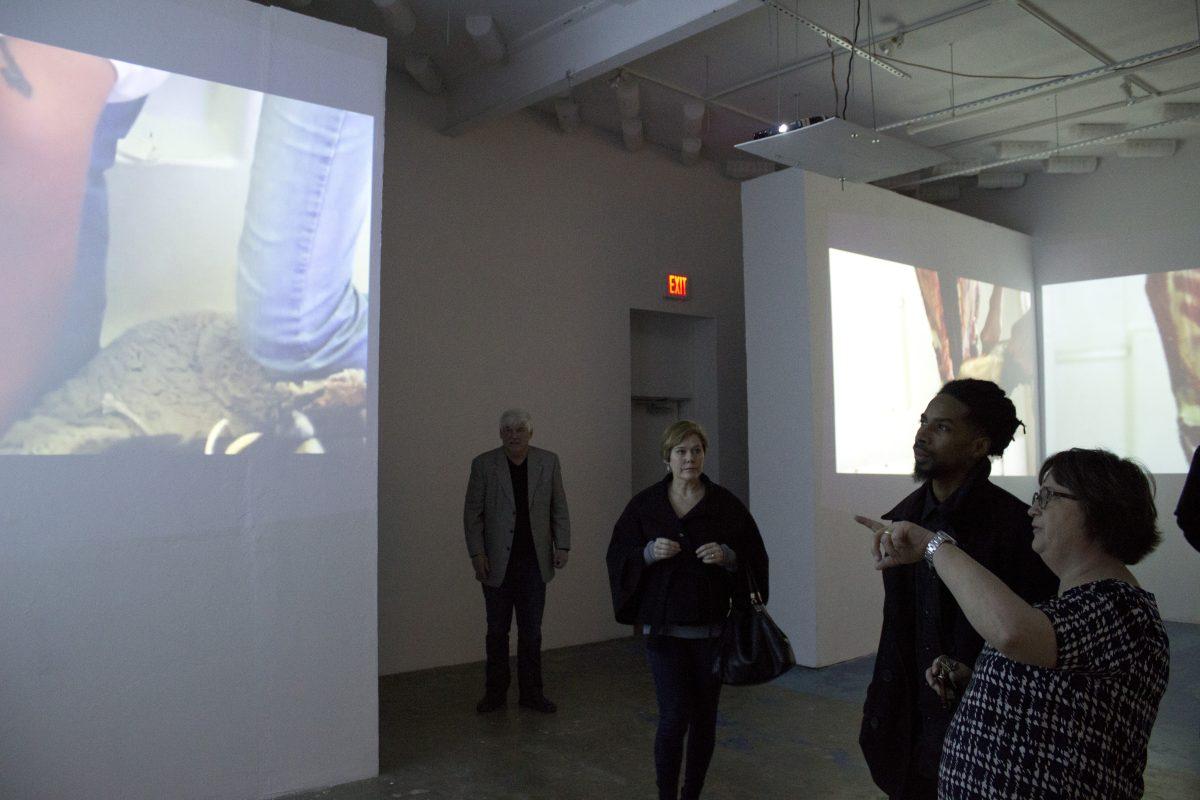Art collective Postcommodity merges indigenous commentary, culture with new aesthetic
A Navajo woman butchering a sheep in a Gallup, N.M. hotel is one of the subjects displayed on four large video projections set high on the white walls opposite CentralTrak’s main entrance.
The work entitled “Gallup Motel Butchering,” or GMSB, is the creation of artist collective Postcommodity. It opened at UTD’s artist residency on Jan. 17. The exhibit will continue running through Feb. 21.
Started in 2007, Postcommodity is an internationally acclaimed Native American art collective. Its members are Raven Chacon, Cristóbal Martínez, Kade L. Twist and Nathan Young. All four of its members are not only prolific artists in their own right, but also immensely varied in their professional interests and creative pursuits. Their work has been featured globally from Winnipeg, California, to Sydney, Australia.
The artists’ heritage drives their artistic purpose, providing a particular perspective on the definition of identity within societies, especially in the increasingly linked communities of the 21st century.
The breadth of this purpose and the diversity of their indigenous backgrounds—Navajo, Xicano, Cherokee, Delaware, Kiowa and Pawnee Nations—lends to the multifaceted nature of the collective’s work. Their inspiration is as much a product of individual passions as it is of shared influences.
“One collective member might feel an influence from an artist or work that another member has never experienced,” Young said. “We have been heavily influenced by noise music, black radical artists, writers and thinkers, Indian casinos, heavy metal, lowbrow culture, American Indian museums, land use and hunting.”
The work featured at CentralTrak focuses on the longevity of Native identity within the context of Western society. It is a significant reality for the collective, as well as a continuing thematic presence in their work.
In the work, a woman is butchering a sheep in preparation for a family celebration. The hotel that is the site for the butchering was constructed on the traditional homelands of the Navajo people.
Though utilizing video, the work is deconstructed into repetitive video stills. Although the length of the entire piece is nine minutes and five seconds, the clips remain on loop. The piece’s commentary on Native identity and Western society is a concern that is not only important within the Indigenous context of the United States, but also globally.
“GMSB may seem very local and specific, but we feel it is truly global in its concern. For us, this would mean that it is equally as relevant to Dallas as it would be to anywhere else in the world,” said Young.
He specified that this dichotomy was unintentional. Rather, Postcommodity sought to expose the reality of Indigenous American people.
“This piece has its origins in what some people call an urban myth, or in this case a rural or Indian myth, a crazy story that as an Indian person you might have heard stories about,” Young said. “We want to tell that story to everyone.”
The exhibit also creates a juxtaposition of silence and noise. The muted projected stills tower above the chatter and soft laughter of guests. With the collective’s well-documented use of sound in other works, as well as the musical backgrounds of its members, Postcommodity’s “Gallup Motel Butchering” is curiously silent.
Postcommodity felt silence was imperative to the efficacy of the artistic work in order to ensure an unembellished scene, Young said.
In short, the purpose of the land to native peoples remains constant. The actions of the woman are inherently normal. She is preparing a family feast as countless Navajo individuals have done before her.
“We did not create this work for shock value or to incite visceral reactions,” Young said. “This installation is a metaphor for what it’s like being an indigenous person living in the world today.”
CentralTrak Director Heyd Fontenot first encountered Postcommodity on a curatorial trip to Santa Fe.
“I came to this job with a wide berth of contacts,” he said. “It’s like a talent shopping trip.”
At first glance, he knew the group’s work had to be shown in the gallery.
The necessity of CentralTrak and the importance of exhibitions like Postcommodity’s remain clear to Fontenot.
“Coming here, you have a sincere look at what we do,” he said. “Art is about making these connections. It’s really important to engage people. Anytime I do a show, I do programming that illuminates the show.”
Artist Janiel Engelstad, head of the organization Make Art with Purpose and a member of Dallas Observer’s 100 Creatives, described Postcommodity’s work as a study of identity at MAP’s “Dialogues on Race,” a panel discussion that took place at CentralTrak on Jan. 22.
“[The artists in Postcommodity] are creating fine art that also has a lot of underlying ideas, whereas I am doing social practice,” Engelstad. “We are both giving voice to people and ideas that are not often given a platform and traditions and histories that are often underrepresented and not seen as important, and that’s where the common ground lies.”







